2018 Nicolai Ion G13 GPI
Size Tested: Medium
Geometry: (Here)
Build Overview:
- Drivetrain: Pinion P1.9 XR Gearbox with Gates Carbon Drive belt
- Brakes: SRAM Guide RSC
- Fork: Fox 34 Elite
- Shock: Fox Float DPS
Wheels: 29”
Travel: 130 mm rear / 140 mm front
Blister’s Measured Weight: 35.93 lbs (16.3 kg) without pedals
Reviewer: 5’10”, 145 lbs
Test Location: Northstar, California
MSRP: $5,500 frame + drivetrain
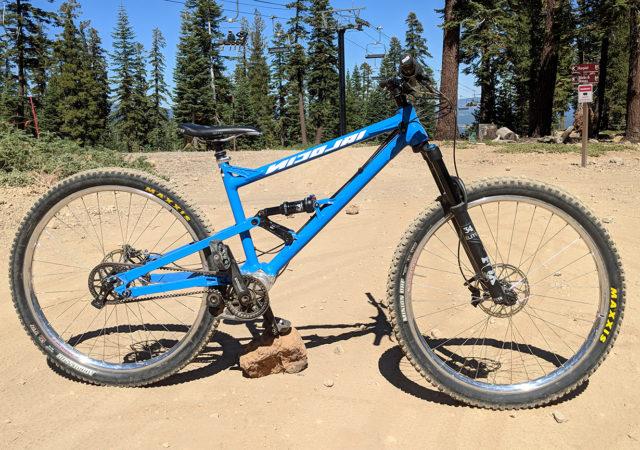
Caveat
We rode this bike at Interbike’s outdoor demo, which moved locations this year and was held at the Northstar bike park in Tahoe. Northstar has some awesome trails, ranging from super rocky, technical trails that were covered in moondust to flowy jump trails that were also covered in moondust.
Normally, Blister tries to get as much time on a bike as we realistically can so that we have time to play around with setup, get comfortable with the fit, and hopefully reveal any durability issues that might arise. But for obvious reasons, spending an hour or two on a bike at Interbike’s outdoor demo doesn’t give us the time to give the bike our usual treatment, especially since we were mostly riding lift-served terrain that was 1) short on climbing, and 2) biased heavily towards the kind of trails you find in a bike park.
That said, there’s a lot of value in riding a bunch of different bikes, back to back on the same trails. Traits that might not be obvious when the bikes are ridden weeks or months apart become evident.
So in other words, back to back comparisons on great trails are useful, but don’t take this as the final word on these bikes, especially when it comes to maintenance and durability issues.
So with all that in mind, let’s take a look at the Nicolai Ion G13 GPI.
Intro
Nicolai has never been a brand that shies away from doing things differently, and in recent years, the brand has become known first and foremost for their extremely progressive take on mountain bike geometry. Mojo Suspension’s Chris Porter has spearheaded this movement within Nicolai, creating his own line known as the Geometron.*
This series of bikes includes a full-on DH rig, Enduro bikes, and a hardtail — all with extremely forward-thinking geometry numbers and the option to choose either a Pinion gearbox or conventional derailleur setup.
So with all that in mind, I hopped on the Ion G13 GPI, which is a super slack, 130 mm Trail bike equipped with a Pinion gearbox and a Gates Carbon Drive belt. Read on for my take on what might be one of the most radical bikes we’ve ever swung a leg over…
*This bike is sometimes referred to simply as the Geometron G13, especially within the UK. I’ll just be calling the bike a Nicolai here, since Nicolai handles the production of the bike.
The Build
The bike I rode at Interbike was a custom build put together by the folks at Pinion North America, so it isn’t really representative of a particular build that Nicolai offers. It seems like Nicolais are most commonly just sold as frames anyway, although Mojo Suspension / Geometron offers complete builds in the UK. These frames are built and painted to order, and are available with either threading for a derailleur or your choice of Pinion gearbox. As far as I know, Nicolai is one of a very small handful of builders to offer this kind of flexibility when you buy a frame.
The build I tested was a mix of typical and unusual components for a media bike. The normal parts: Fox suspension, a Fox Transfer dropper, Sram Guide RSC brakes, a Race Face Turbine 35 aluminum bar, a WTB saddle, and Maxxis rubber. No big surprises there.
The 140 mm Fox 34 Elite fork would ordinarily be a fine choice for a bike with 130 mm of travel out back, but after riding this bike, I would actually opt for a beefier fork, despite the bike’s minimal travel. But that’s more of a testament to this bike’s superb descending capability than a jab at the 34.
A slightly more unusual choice was the Velocity Blunt 35 wheelset. I hadn’t spent any time on these wheels before this review, but they gave the tires a lot of volume and felt plenty stiff for aluminum hoops.
Of course, the truly unique part of this bike is its drivetrain, which brings us to the next section…
The Drivetrain
Let’s talk about what is arguably the most unusual part of this already atypical bike. The Nicolai I rode was equipped with Pinion’s P1.9 XR gearbox in place of a derailleur. This particular model gets you a 568% range over 9 individual gears, although Pinion also offers other gearboxes with smaller gaps between gears and larger overall spreads.
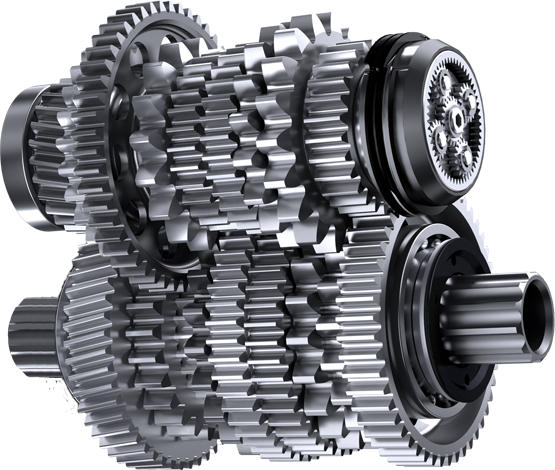
The unit I rode was equipped with a Gates belt instead of a chain, which is currently pretty unusual for full-suspension gearbox bikes. The belt is secured via a spring-loaded tensioner / bash guard unit designed by Nicolai that adjusts for belt growth when the suspension compresses.
If you want in-depth details on how the gearbox itself actually works, I’d highly recommend checking out Pinion’s website. But as a very basic summary, the gearbox itself works via two stacks of gears that are constantly engaged with one another. Pawls inside the box engage to select different gear “pairings,” which give you your 9 individual gear ratios.
The construction of a gearbox is dramatically different from a derailleur system, so not surprisingly, the user experience is also different. First off, you don’t need to pedal to shift gears. This means you can shift multiple gears while coasting, in the air, or even in the apex of a corner. Gearboxes also offer wider gear ranges, dramatically improved suspension sensitivity and weight distribution on the bike, and of course, a nearly maintenance-free drivetrain. Not only are these things pretty cool on paper, they’re distinctly noticeable on the trail.
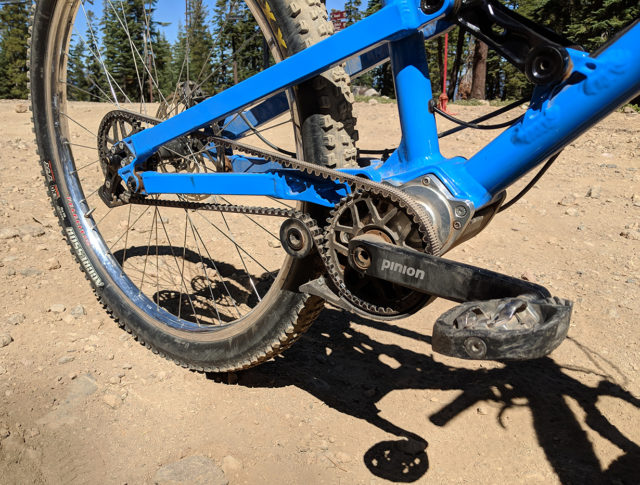
It’s also harder to shift the gearbox when you’re putting a lot of torque through the drivetrain, so you end up figuring out how to either force the bike into your desired gear, or just start timing your shifts differently in relation to your pedal stroke. This definitely takes some learning time, which seems to vary quite a bit among riders. For another reviewer’s perspective on this learning curve, it’s also worth checking out Noah Bodman’s review of the Zerode Taniwha Trail.
I fully believe that with an open mind and some practice, everyone can reap the benefits of internal gearing. But if you go into the experience expecting the gearbox to shift exactly like your derailleur, you’re probably going to miss out on a lot of the things that make this type of drivetrain enjoyable to use.
And for the sake of objectivity, it’s worth noting that I’ve already spent a significant amount of time riding internally geared bikes — I’ve ridden a handful of bikes with Rohloff hubs, and currently have a bike with a Pinion gearbox in my quiver.
So what all of that means within the scope of this review is that I already knew how to get the drivetrain to do exactly what I wanted the moment I swung a leg over the Nicolai. And that in turn enabled me to dedicate more of my attention to the bike’s suspension performance and insanely progressive geometry — because let’s face it: there’s a lot more to this bike than just the gearbox.
Fit and Geometry
Nicolai has always been known as an early adopter of the long and slack trend, and this bike is no different. Even in 2018, when most brands have become pretty hip to the trend, the size Medium test bike I used pushed the limits of both geometry and sizing.
The size Medium that I rode has a reach of 490 mm, and the smallest size available has a reach of 460 mm. Even today, this is roughly the reach offered on many brands’ size Large Trail bikes. For some perspective, most of the bikes I usually ride have reach measurements between 430 and 455 mm, and I’m 5’10”.
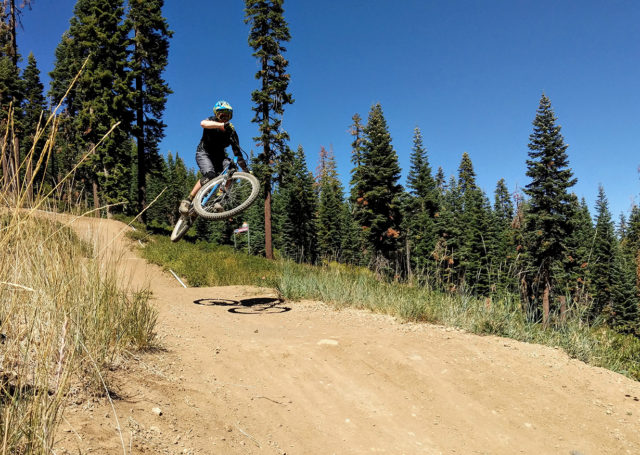
Nonetheless, the bike I rode is exactly what Nicolai recommends for my height. And I’ll admit that while the 642 mm effective top tube initially felt long, I would not say that it was particularly hard to control or uncomfortable to ride. When pedaling, the 76° seat tube angle kept me in a fairly neutral position on the bike. And when descending, I was able to get much more over the front of the bike than on a “conventionally sized” bike without fear of ejecting myself.
Accompanying the bike’s massive front triangle is an appropriately long 445 mm chainstay, which Nicolai runs on their Small, Medium, and Large frame sizes. The size XL and XXL get 451 mm chainstays.
Of course, a bike like this wouldn’t be complete without a super slack head angle. I rode the bike in its low mode, which gave it a 64.5° head angle — not far off from plenty of DH bikes from years past. In its high mode, the head angle is 65.2°, which, given that this bike is billed as a 130mm-travel all-rounder Trail bike, is still quite aggressive.
The Ride
Climbing
Since this test took place at the Northstar bike park, I didn’t have to do much climbing on the Ion G13 GPI, so my data on the bike’s climbing performance is minimal. But for what it’s worth, the pedaling I did on the bike didn’t feel particularly different than most other single-pivot, FSR, or Horst-link bikes I’ve ridden.
The Nicolai is an active bike that lays down tons of traction whether sitting or standing, and it didn’t bob appreciably — even with the shock open. It doesn’t provide that feeling of stiffening under power that you sometimes get out of linkages with higher anti-squat values, which means that it doesn’t feel like a super lively sprinter in a simple parking-lot test.
On the other hand, this lets the rear wheel track the ground extremely well, whether you’re on the gas or not — a trait that I often find is missing from bikes that stiffen up a ton when you’re on the pedals. And since this bike doesn’t have a derailleur to move the belt around (and thus change the way pedaling affects suspension performance), this ground-hugging characteristic is identical in every gear.
Due to these characteristics and the bike’s weight, I was most happy sitting and spinning on the Nicolai. Conveniently, the wide range of the gearbox allows this in pretty much any terrain.
Descending
On the way down, the Ion G13 GPI is hands down THE most composed 130mm-travel bike I’ve ever ridden.
This isn’t subtle. I’m talking about a serious, night-and-day difference in descending performance between this bike and anything else in its travel class.
The centered weight gives it a balanced and predictable feel in the air, and even though it’s clearly not a spritely little Trail bike, I had no problem throwing it around. So at the very least, I can comfortably say that the Nicolai is certainly a more playful bike than the numbers might suggest.
But where the bike really excels is in its suspension performance. Whether going slow or fast, the suspension simply devours bumps of any size. And I attribute this almost entirely to the fact that the bike is missing a big, heavy derailleur and cassette on the end of its swingarm.
The idea of this comes down to pretty basic physics. By reducing the amount of weight on the end of the bike’s suspension linkage, Nicolai is effectively reducing the amount of energy it takes to get the suspension moving when it encounters a bump.
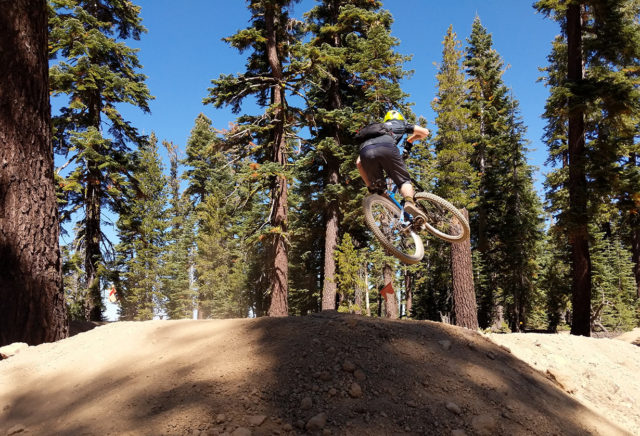
Essentially, this means the Nicolai’s suspension is more sensitive to smaller bumps. And in scenarios where the rear suspension is changing direction really quickly (e.g., trail chatter and braking bumps). This means the bike follows each minuscule undulation in the terrain with an incredible level of sensitivity — one that I have never experienced on any derailleur bike. And quite often, I felt like I was holding more speed through rough terrain because of this trait.
Of course, assisting the bike’s suspension performance are its big wheels and super aggressive geometry, which make the bike remarkably difficult to unsettle. Particularly with off-camber rock gardens or steep ledges, the bike’s length and aggressive angles always kept it planted and pointed the right direction. Because of this, the bike is best ridden purposefully. Look far down the trail, commit to a line, and push the bike through it. Again, this is not how your ordinary, run-of-the-mill, 130mm bike wants to be ridden.
As for how the geometry affects cornering, I could imagine occasional situations where such a long bike would be a bit of a handful through extremely tight switchbacks. If you primarily ride terraced hiking trails with straight sections followed by tight switchbacks, I can’t imagine this geometry making much sense. But in my brief time on the bike (granted, in a bike park), I got the bike through corners without any real trouble, and felt like I was carrying plenty of speed out of the exit of each corner.
The length and extra-slack head angle made me super happy getting way over the front end to weight the front wheel, leaning aggressively, and really driving the bike through corners with my upper body. And I’m happy to say that this was a significantly more intuitive adjustment than I would have expected. Given that the bike’s geometry was so drastically different than what I typically ride, I felt really comfortable going fast on the bike almost immediately. That said, I also have a hunch that with a little more time on this bike, I could even further develop my form to suit the bike’s geometry and become even more confident cornering aggressively on it.
Bottom Line
Bikes these days tend to fairly predictably occupy a space somewhere on the travel, geo, playfulness, and stability continuum. As travel increases throughout a brand’s model lineup, bikes generally get slacker, more stable at speed, and more capable on descents. Sure, different brands will mix and match these characteristics in different proportions, but if you look at a lot of the most popular bikes of any given travel category, you’re going to find an uncanny number of similarities both in their numbers and how they ride.
And then there’s the Nicolai Ion G13 GPI.
This bike occupies a space within the travel / geo / playfulness / stability continuum that no other bike I’ve ever ridden really hits. It’s way heavier than any “normal” 130 mm Trail bike, has super slack geometry, and is more stable and composed on rough descents than plenty of Enduro bikes (yes, seriously). Despite all this, its centered mass keeps it balanced in the air and pretty fun to throw around. It also has a unique drivetrain that delivers a fundamentally different user experience, meaning that new users will have to spend some considerable time getting used to a new way to shift their bike.
I had an enormous amount of fun on the blue Nicolai, but I’m also fairly certain that the audience for this bike will be pretty narrow, as it’s simply never going to be the spritely-yet-capable all-rounder that most consumers have come to expect out of this travel category.
But if you’re sick of breaking and maintaining derailleurs, want to ride your Trail bike like it’s a DH bike, and don’t care about what “130 mm” is supposed to designate, then the Nicolai starts to look pretty sweet. It’s an unorthodox bike that may not appeal to the center of the bell curve. And maybe that’s okay, because the riding experience it offers is truly like nothing else in its class. For that, Nicolai should be commended.

Sick.
Pole review next?